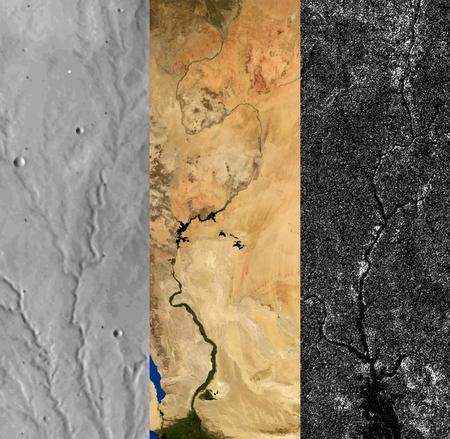Experts explain origins of topographic relief on Earth, Mars and Titan

These are river networks on Mars, Earth, and Titan. From top to bottom, images span ~100 km on Mars, ~2000 km on Earth, and ~400 km on Titan. Credit: Benjamin Black, adapted from images from NASA Viking, NASA/Visible Earth, and NASA/JPL/Cassini RADAR team.
In their paper “Global drainage patterns and the origins of topographic relief on Earth, Mars, and Titan,” published in the latest issue of Science, the team identifies plate tectonics on Earth as one key difference.
Plate tectonics is the theory that Earth's crust is made up of large, moving pieces called plates. The relative motions, regeneration, and recycling of these plates continuously reshape the surface of the Earth, in the process uplifting topography in some areas much more than others. As mountain ranges jut up, they can divert rivers as they flow toward the sea.
While the origins of the topography on Titan remain somewhat mysterious, Black's research team discovered that the rivers there, likely carved by liquid methane, have not been as thoroughly rerouted as rivers on Earth.
“It's important to realize that almost every aspect of Earth's surface has been shaped by plate tectonics,” Black says. “So there is nowhere we can look to see what landscapes would look like without plate tectonics. That's where Mars and Titan come in. We can use these three worlds as natural experiments. They are like siblings that have followed different life paths.”
“Before the discovery of plate tectonics, there were all kinds of theories for the origins of Earth's topography,” Black adds. “What really fires my imagination is thinking about the sheer possibilities even in our solar system. One of the big takeaways from our research is that each world seems to strike its own balance in terms of the processes that are shaping the surface we see.”
###
The research team also included Taylor Perron (MIT), Douglas Hemingway
(UC Berkeley), Elizabeth Bailey (Caltech), Francis Nimmo (UC Santa Cruz) and Howard Zebker (Stanford University).
Media Contact
All latest news from the category: Physics and Astronomy
This area deals with the fundamental laws and building blocks of nature and how they interact, the properties and the behavior of matter, and research into space and time and their structures.
innovations-report provides in-depth reports and articles on subjects such as astrophysics, laser technologies, nuclear, quantum, particle and solid-state physics, nanotechnologies, planetary research and findings (Mars, Venus) and developments related to the Hubble Telescope.
Newest articles

Silicon Carbide Innovation Alliance to drive industrial-scale semiconductor work
Known for its ability to withstand extreme environments and high voltages, silicon carbide (SiC) is a semiconducting material made up of silicon and carbon atoms arranged into crystals that is…

New SPECT/CT technique shows impressive biomarker identification
…offers increased access for prostate cancer patients. A novel SPECT/CT acquisition method can accurately detect radiopharmaceutical biodistribution in a convenient manner for prostate cancer patients, opening the door for more…

How 3D printers can give robots a soft touch
Soft skin coverings and touch sensors have emerged as a promising feature for robots that are both safer and more intuitive for human interaction, but they are expensive and difficult…





















